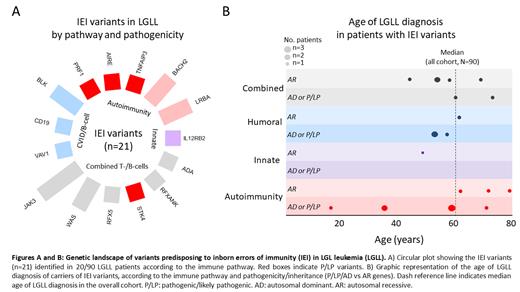T-cell LGL clonal proliferations occur in the context of various diseases of the immune system. These associations constitute a unique research framework to discern whether the expanded clones are triggers or sequels of the concomitant disorders and, more importantly, when and how they should be targeted. While the relationship of LGL leukemia (LGLL) with autoimmune diseases is well established, the exact pathogenic connection between them remains unknown and, probably, it is not a one-way process. We previously described a syndrome whereby LGLL co-occurred with pure red cell aplasia (PRCA), thymoma, and Ig deficiency. 1 Thus, one could speculate that, paradoxically, certain forms of immunodeficiency may lead to compensatory overreactions, resulting in autoimmunity and, ultimately, in clonal LGL proliferations. Indeed, Ig deficiency is frequently encountered in our series of LGLL (n=62, 32%). While acquired conditions ( e.g., thymoma, B-cell dyscrasia) may explain some (31/62, 48%) of these cases, congenital immune defects may have a complementary, even overlapping, pathogenic contribution.
Here, we identified a 36-year-old woman with history of candidiasis, IgA deficiency, T1DM and Crohn's disease, with concurrent diagnosis of PRCA and LGLL. NGS revealed a germline heterozygous variant of uncertain significance (VUS) in BACH2, a gene involved in a recently reported inborn error of immunity (IEI) characterized by lymphocyte defects, Ig deficiency, and intestinal inflammation -features all depicted in our index case. This patient inspired us to posit that germline variants involved in IEI may also contribute to the pathogenesis of LGLL.
To that end, we assessed the presence of IEI defects in 90 LGLL cases by performing WGS. We screened for variants in 90 IEI genes, covering different immune pathways. After applying a stringent variant calling, rare variants were defined as those with allele freq.<1% across genome resources. Variant pathogenicity was assessed according to ACMG criteria. For analysis, we selected all pathogenic/likely pathogenic (P/LP) variants, and VUS overrepresented in our cohort (significant p-values for Obs. vs Exp. freq. after multiple-testing correction).
We found 21 variants in 15 IEI genes, carried by 20 LGLL patients (22%). The combined allelic burden for these variants was 12% ( vs the expected 2% in normal population). According to the role in immunity, the variants clustered in 2 main IEI categories: autoimmunity/immune dysregulation, and combined T-/ B-cell defects ( FigA). All variants were heterozygous, and 10/21 involved genes associated with dominant traits. Four defects in 3 patients were P/LP, and mono-allelic burden of 3/4 of these variants, involving the genes PRF1, AIRE and TNFAIP3, appeared to be a sufficient basis for immune imbalance leading to disease.
When we analyzed the clinical features of the carriers of IEI variants, we observed that they were associated with diagnosis of LGLL at a younger age (median: 58 vs 64 yrs., FigB), including the patient with the earliest diagnosis of LGLL in our cohort, 17 yrs., who carried a PRF1 pathogenic variant. Carriers vs non-carriers had a higher proportion of autoimmunity (63 vs 43%), Ig deficiency (33 vs 23%) and other B-cell dyscrasias (58 vs 39%). Finally, carriers also had a significantly higher prevalence of cytopenias (94 vs 73%, p=.05) and particularly immune-mediated cytopenias (42 vs 17%, p=.02) than non-carriers. Most of these associations, including the predisposition to bone marrow failure (BMF) and immune cytopenias, persisted for the carriers of P/LP and dominant defects (since VUS in genes involved in dominant vs recessive traits are more likely to be of clinical relevance).
Our findings suggest that variants predisposing to IEI can be found in the setting of LGLL. For some of these cases, the genetic burden might be strong enough to overshoot autoimmunity, promoting clonal LGL expansions. Environmental agents may have cooperative roles, and particularly infections, to which these patients may be intrinsically predisposed. Such atypical cases might exhibit distinct features, e.g., earlier onset of LGLL diagnosis, or concurrent BMF, which may serve as red flags tied to the underlying adult-onset IEI. Our study proposes an alternative pathogenesis for a significant fraction of cases with LGLL, and gives us the impetus to expand the IEI spectrum to the field of BMF and clonal hematological disorders.
Disclosures
Maciejewski:Alexion: Membership on an entity's Board of Directors or advisory committees; Regeneron: Consultancy, Honoraria; Novartis: Honoraria, Speakers Bureau; Omeros: Consultancy.


This feature is available to Subscribers Only
Sign In or Create an Account Close Modal